
This is it folks…
We’re at the end of the Disney Renaissance. Or, more appropriately, the time where most people mark the end of Disney’s esteemed Renaissance era of animated features. We’re at the last film in a streak of box office successes, the end of an apparently idyllic time that soured a bit in the latter half…
At this point in time, Walt Disney Feature Animation had already mastered getting one new film out every calendar year while keeping the visual quality consistent. In the past, that seemed like a pipe dream. Prior to the late 1980s, you had to really wait for new Disney animated features. Three years, sometimes four. Before World War II knocked the stands out from under Walt’s studio, the plan was to get one feature out every year. Pinocchio and Fantasia opened at the beginning and end of 1940, respectively. Dumbo bowed in 1941, Bambi was released in 1942. Walt’s return to the single-story animated feature in 1950 with Cinderella did not bring back the one-a-year plan. More time was taken on features, and Walt devoted time to several other projects.
Originally, the Renaissance-era pictures were holiday season events. All late November releases that took advantage of Christmas, other holidays, winter vacation, and especially a time perfect for movie tie-ins and merchandise. The Lion King put an end to this, the film that was originally set for a fall 1993 release ran into numerous story problems. Instead of making audiences (who were starving for more after Aladdin‘s run wrapped up) wait till the end of 1994 to see the next epic, they etched in a June 1994 release date. The Lion King became Disney’s highest-grossing animated film, and their biggest film of any kind, period. All future Disney animated films would be June releases until the end of the Renaissance.
A lot had happened, however, between the June 1998 release of Mulan and the June 1999 release of Tarzan…
The autumn of 1998 was a time when other distributors struck back. Their initial plans to get a piece of Disney’s cake went belly-up in the early 1990s, so they tried again… And did they!
Spearheading the new wave of competition was Jeffrey Katzenberg, the former chairman of Disney Animation that had a bone to pick with CEO Michael Eisner. He formed DreamWorks with Steven Spielberg and David Geffen, and immediately jumpstarted an animation wing for them. He went all out, too, bringing in powerhouse computer animation studio Pacific Data Images to aid them. DreamWorks Animation would do the traditionally animated films, PDI would do the films that would compete with Pixar’s.
They entered the ring with a one-two punch, the CG Antz and the 2D The Prince of Egypt. Both wearing “cool” PG ratings, both sported violence and more adult-oriented content. The Prince of Egypt did quite well for itself, while Antz seemed to do alright at best. The actual budget of that film seems to be ambiguous for some reason. Paramount lucked out with the movie adaptation of the hit Nickelodeon animated series Rugrats, the movie became the first non-Disney/Pixar animated film to top $100 million at the domestic box office.
It wasn’t just Disney’s game anymore, it seemed. While The Rugrats Movie was rightfully taken on its own terms, critical reception for Antz and The Prince of Egypt was pretty impressive. Finally, someone who had competed with Disney by not making an innocuous wannabe Disney film with a noticeably lower budget. Despite all of this, Mulan still made more than these films domestically and worldwide, but this showed that someone was willing to gear up and try a bit harder. Whatever reason it may have been. Compared to most of the animated movies of the early 90s, Antz and Prince of Egypt are good, but their attempts to be adult are phony. Katzenberg wanted to stick it to Disney, even though it is he who watered down Disney’s animation for younger audiences to begin with.
Then you had Pixar’s second feature, which opened amidst this maelstrom… A Bug’s Life outgrossed Mulan domestically and worldwide, it also pocketed more than what Beauty and the Beast made in North America. In late 1998, A Bug’s Life was the fourth highest grossing animated film at the domestic marketplace. That put it behind The Lion King, Aladdin, and Pixar’s debut, Toy Story. A Bug’s Life did so well not only because it was a brand spanking new CG film (keep in mind, young’uns, computer animated movies were a *huge* deal back then), but because it was very good and it was not a Disney Renaissance-style picture. No musical numbers, no “I Want” slop, no forced in silly sidekicks, no desire to be a prestige picture/Academy Award frontrunner, you get the idea…
Pixar operated independently of the big guys at Disney, while Walt Disney Feature Animation still had to adhere to a worn-out formula. We would finally see the last of these formulaic pictures in the summer of 1999…
Tarzan.
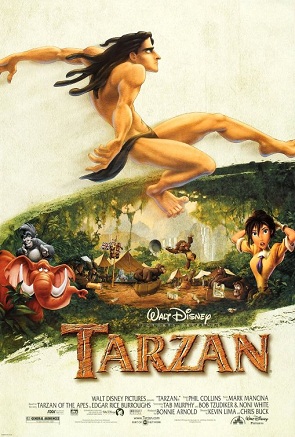
Was it a strong finish? Did it take all of those Renaissance cliches, and do something neat and new with them?
In many ways, Tarzan is like an amped up version of Mulan. Mulan, for all its faults, at least tried to be more than just another Disney Renaissance film. It had big-scale action and war, and there was no major romance story, songs were more low-key and didn’t quite dominate the picture. Almost to the point to where they were not needed. Tarzan beefs up the action, but keeps the love story, keeps the songs, the silly sidekicks, and it still has a giant climax where a clear-cut bad guy has to be stopped. It’s a 90s Disney film through and through. Like many of the other Renaissance pictures, it’s also an adaptation of material that some feel that Disney has no business tackling. That pesky “Disneyification”, right?
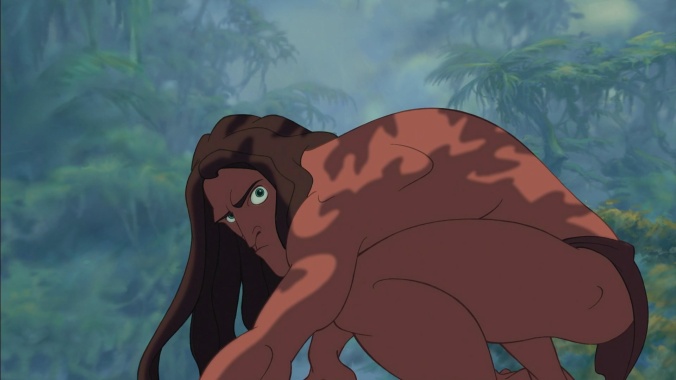
No matter how close Tarzan may follow the first book in Edgar Rice Burroughs’ series, does it work on its own? Do the Renaissance cliches hurt or help? Like Mulan, it’s a bit of both. Tarzan eschews the more complicated ideas of the book Tarzan of the Apes, and prefers to be an emotional story about a man choosing between two lives, and dealing with the conflicts that come from both sides. They make Kerchak, the gorilla who killed Tarzan’s human parents, be his reluctant surrogate father. There’s no plot involving Tarzan coming to the human world, it’s all kept in the jungles of Africa.
I actually like the story they go for. Tarzan is immediately despised by Kerchak (who is based more on the Tublat character from the book), but loved by his adoptive mother Kala. All throughout his childhood, the bitter gorilla does not approve of him, and even halfway through the film when Tarzan’s an adult, he keeps that coldness. The story is really about Tarzan striving to achieve respect from Kerchak by protecting his ape family. The problem is, when he sees humans for the first time, he falls in love with explorer Jane Porter. Here, the Disney Renaissance formula morphs the story into Pocahontas 2.0, where it’s more Romeo & Juliet than it is Burroughs’ ape man stories.
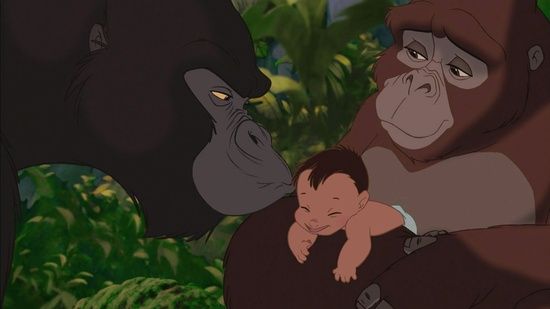
For the most part, they tell that kind of story better than Pocahontas did, because at least it’s adapting fiction and not using events in American history as the main structure. I’m sure these changes and elements grated on those who always had the knives out, always ready for Disney to do their usual “worst” to these beloved classics. You ever wonder why Disney Animation barely adapts anything outside of told-and-retold fairy tales in this day and age? It’s probably because not too many stories like the Tarzan novels can be molded into family-friendly stories. We may be long past the worn-out Renaissance formula, but Disney still backs off. The closest they ever got was a possible adaptation of Terry Pratchett’s Discworld novel Mort, other than that? Outside of Marvel properties, it’s either fairy tales that have been adapted a million times (and with films like Tangled and Frozen, the original fairy tale’s premise is all but a base. They craft their own story around that.) or all-original stories like Wreck-It Ralph, Zootopia, and Moana.
Personally, I’d like to see Disney Animation try again with this sort of thing, now that the people in charge back in the 1990s are longer within the building. Walt adapted a whole slew of material into animated features, not just fairy tales. He and his crew took on properties like Bambi, A Life in the Woods, the Alice in Wonderland books, Peter Pan, The Hundred and One Dalmatians, The Sword in the Stone, and The Jungle Book. Problem is, that was during the pre-MPAA days, when there was a strict code that forbid movies to be darker or more in the realm of a modern PG-13 movie. Walt Disney, however, did not apply a formula to his adaptations. He was able to make most of these stories uniquely his, without insulting the intelligence of the audience or leaving a lot to be desired.
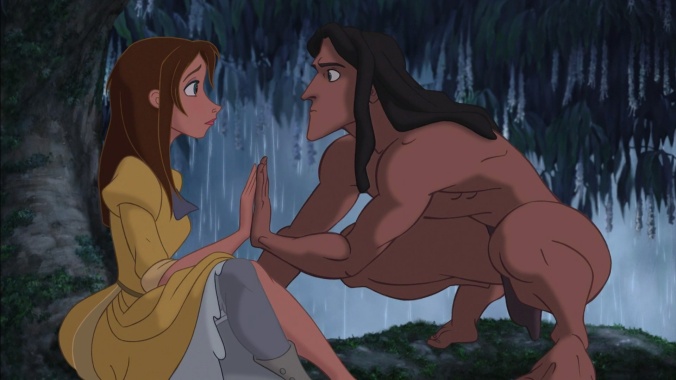
Flash-forward to the mid-to-late 1990s. After the hat tricks of The Little Mermaid, Beauty and the Beast, Aladdin, and The Lion King got a bit old, it was crucial for Disney to back away from this formula, but they didn’t. The previous string of movies proved to be a little divisive, some more so than others. Tarzan more or less works as a Renaissance picture, but what it does right, I feel it does really right.
Outside of the story of Tarzan being torn between two worlds with an obvious bad guy escalating the tension, Tarzan is an excellent example of an animated action film. You don’t often see American feature animation try to compete with big-scale blockbuster action. But if you let it, with the right budget and right crews, you can equal it… If not top it! Tarzan‘s action set-pieces are like miniature masterpieces on their own. Every one of them! Tarzan’s battle with the vicious leopard Sabor, any time he tree surfs, Jane’s pursuit by an angry baboon fleet, the climax… Everything about these action sequence is perfect, the staging, the color work, the editing, the sheer energy… I can gush over them all. Damn. Day. The film is one I turn to when crafting animated action sequences.
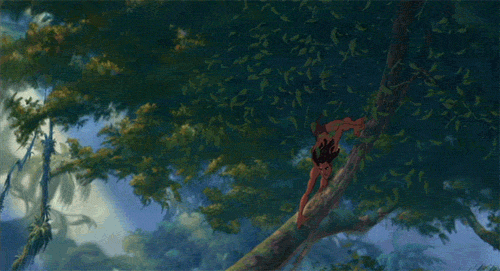
That’s to say nothing of the animation itself. Dear lord. Every frame in this film is perfection, and to me this is some of the highest Disney’s traditional animation ever got in the post-Walt decades. The art direction? Jaw dropping. The minimalism of Hercules and Mulan ain’t here, the level of detail here is astounding. Computer animation is blended in a way that perfectly suits the action. Sure, we can tell a lot of those trees and effects are CG, but consider the staging and how fast you see it… It’s like you can’t tell almost! Disney utilized a system called Deep Canvas for this film’s setting, and goodness did it suggest a lot of potential!
It makes the sequences a bit tough to watch, because you know… You know what happened to traditional animation at Walt Disney Feature Animation and the American animation industry as a whole. If these pioneering techniques continued to be used in traditional animation all throughout last decade and this decade, my goodness, just think about where we’d be right now! The shorts Paperman and Feast would look primitive! This is another rant for another day, I’ll save the choice words for the day I review the post-Renaissance films… That won’t be pretty!
Long story short, I too am still extremely bitter about how traditional animation was handled – and continues to be shunned – by these studios…
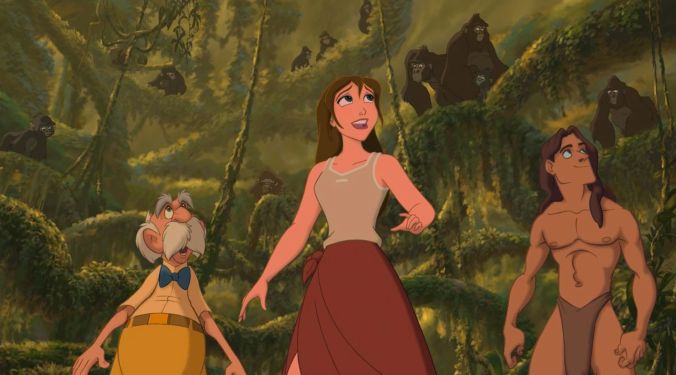
So, Tarzan is a pulse-pounding action movie. Blending perfectly with this is the more tender love story, which is handled quite well. Jane is a great character, dare I say a lot more interesting than Tarzan himself. Sadly, some of the comic relief characters – because this is a Disney Renaissance™ movie – couldn’t be any more out of place. Yes, Terk is pretty much the Hunchback Gargoyles of this movie. Voiced be an equally obnoxious Rosie O’Donnell, she’s bouncy and 90s “attitude!” rolled into one, and is mostly unfunny. Some of her ape buddies also don’t fit. A neurotic Wayne Knight-voiced elephant named Tantor fares a little better, but on the whole the comic relief characters don’t gel with the more carefully-animated characters and situations.
Since it checks almost all those 90s boxes, what about the music? I’ll be the outlier here and says that Phil Collins’ love it or hate it soundtrack… Works.
For once, no breaking out into song! Okay, well there’s some, but it’s minuscule! Having Collins’ sing the songs offscreen reminds me of Dumbo and Bambi, two films that benefited from not having characters sing songs onscreen. They don’t sound like Broadway wannabes either, though they do kind of fall into that New Age pop syndrome that was probably beyond annoying by 1999. See, I was born in 1992, so I have no idea why Phil Collins is so hated. I remember seeing a little while back that people petitioned (!) to stop Collins’ coming out of retirement, was he really that obnoxious in the 1980s and 1990s? I think Genesis is awesome, and some of his solo stuff’s cool too!
I guess it was a real case of “you had to be there”…

Only one song falls completely flat, and that’s ‘Trashin’ the Camp’. An executive-ordered lump of slop, it stops the movie dead in its tracks and knocks the tone off course like an asteroid. At first, the scene of the apes fiddling around with the human objects and devices at the camp is fun stuff, but it did not need to be this full-blown musical number. A sequence where they just wreck stuff, leading everyone to the camp, would’ve been just swell. It’s barely even a song, it’s just Rosie and some singers belting out some random quasi-jazzy gibberish. Yes, it’s a mud stain on the tapestry.
Anyways, I like Collins’ songs. They may be on the nose, but they sound pretty and match up with the scope of the film. This movie didn’t need musical numbers at all, but at least they work. Worse case scenario, they’re there and they don’t work. I know for some, the soundtrack is just that. For me, oddly enough, it’s good stuff. Now you want an out-of-place Phil Collins soundtrack in a Disney animated movie? Try the one that came out four years after this movie.
We’re left with a movie that is basically a much better Pocahontas, a heartfelt action-adventure that has marvelous visuals all throughout, and some genuinely lovely moments. The somewhat forced villain Clayton (not sure why they named him after Tarzan’s real name in the books) isn’t terrible, but he could be more. He’s not Ratcliffe, thankfully. The ending is on I’m not too big on as well, I kind of would’ve preferred if Tarzan left the jungles for London, but I guess that’s just me. The film’s Renaissance cliches and downfalls do hold it back from being a truly great film, but the things it does right? They’re like really shiny gems in a rock pile.
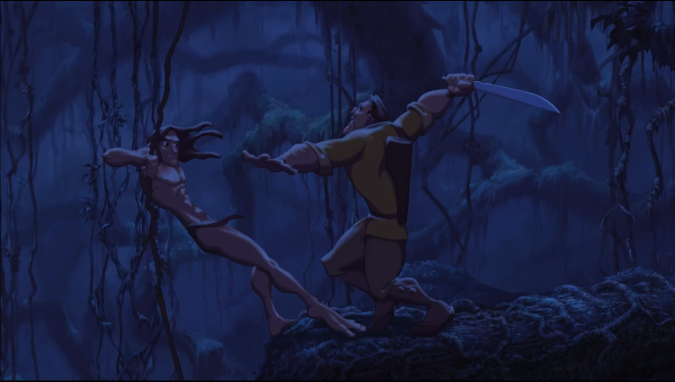
I really think if this were the movie to come out after The Lion King, perhaps the Renaissance still could’ve been firing on all cylinders instead of seeing a steady decline. Sure, it may be a generic film that uses the Mermaid/Beast-template, but the action and spectacle could’ve worked out in its favor.
Luckily, back in 1999, it somewhat did.
Tarzan opened at #1 at the domestic box office, something a Disney animated feature didn’t do since Pocahontas. A strong $34 million, more than ten above the low-20 hauls the previous three features collected on their respective opening weekends, something went right! This was $6 million behind the then-current record-holder, The Lion King. Legs-wise, it played out more like Pocahontas, which was still pretty decent. Taking in a fine $171 million domestically and $448 million worldwide, it was their biggest post-Lion King animated hit. At the time, this was the third highest-grossing animated film at the domestic box office and up in there in the worldwide charts!
Perhaps a few changes of pace is what helped, perhaps it was the thrills and spectacle. After all, CGI was still a huge deal back then. Back when CGI seemed to mean instant box office success. It obviously struck a chord with more folk than the other films did. The Renaissance ended, quality-wise, on a good note. Not a spectacular climax, if you want an example of that… Watch the final film in Disney’s 1st Golden Age of Animation. That film was Bambi, and that Golden Age ended because of World War II.
Disney’s 2nd Golden Age of Animation, or Renaissance, or whatever you want to call it… If we are to take the summer of 1999 as the “official” end, then Tarzan ended it with a loud and vibrating thud. Not a bang, but still pretty sound. By this time, it was clear that animation was here to stay. Disney’s successes, along with rising newcomers Pixar and DreamWorks, kept feature animation on stable grounds. In 1989, things were still a little uncertain as the medium was slowly lifted above possible extinction.

A spade, however, is a spade. The Renaissance was anchored by the Disney brass’ ignorance. The continuing stigma that animation, and mostly Disney’s animation, is a children’s thing bled its way into this successful era. Almost all of these films were compromised, held back from being what they should’ve been. That lingering order that 6-year-olds had to be catered to, Disney’s animated films of the 90s were not the truly universal films of Walt Disney. If anything, Disney’s animation became childish and pretty corporate during this very era, by contrast to the mindset that says animation got “more adult” after the success of The Little Mermaid.
During the Golden Age, animation was animation. Cartoons and feature-length stories were made for adults, but were appropriate for most children to view due to the standards and rules in Hollywood at the time. Disney didn’t change or adapt after Walt’s death in 1966, the introduction of the rating system in 1968 didn’t change the company head’s minds. Disney stuck to making family entertainment, in a world that now saw films that were very inappropriate for a younger audience. The Renaissance films may have had more bite than most of the innocuous 70s and 80s fare, but that “kiddie factor” was still there.
Meanwhile, it seemed like the folks at Pixar – who avoided the notes supplied by the suits at Disney – were making animated films that were as universal as Walt Disney’s early films. Toy Story, A Bug’s Life, and Toy Story 2 weren’t targeted at any particular audience, and they soared critically and commercially because of that. DreamWorks on the other hand made films for preteens, and this would later come to bite them in the rear. No doubt a product of Jeffrey Katzenberg’s misunderstanding of animation, not dissimilar to how he had the Disney films watered down for kids, he tried so hard to make DreamWorks “adult” and “edgy”. Even he’s confused as to why he did this back in the day. Other competitors set up shop only to run into brick walls.
We entered a new era in animation with the Renaissance, and from that point onward, feature animation was no longer in the danger of being relegated to toy commercials or come-and-go fare.
Where would Disney’s animation be after this long and mostly fruitful period? What came out in the wake of the formulaic Renaissance pictures?
Until next time, my friends…
Didn’t A Bug’s Life have a song with “Time of Your Life” at the end credits? Or are you only referring to the “burst out into song”-type?
LikeLike
Fixed it. Meant “burst out into song”-types.
LikeLike
Pingback: Breaking Down the Latter Disney Renaissance, Part 4 | Kyle Loves Animation and More…
The sidekicks and Clayton held back the film from being extremely magnificent, and they were so close to breaking from the formula. I still believe that if they continued with the path of Mulan and Tarzan in the Post-Renaissance, things would have continued to go upwards. If one of those two films were released in 1995 instead of Pocahontas, things probably would not have went down. It’s funny how most of the films released after Pocahontas was better than it.
LikeLike
I think if Walt Disney was to be alive during when the Hay’s Production Code was replaced by the MPAA rating system, I think he would’ve considered making more adult films. After his premature death, the company was struggling due to gearing films towards kids.
LikeLike